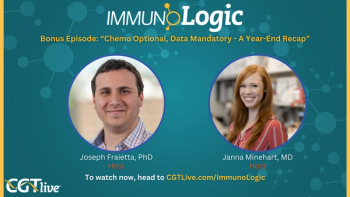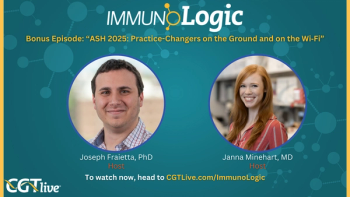
UX111 Shows Continued Dose-Dependent Efficacy as an MPS IIIA Treatment
Ultragenyx’s self-complementary AAV9-based gene therapy reduced levels of relevant CSF biomarkers, as well as improvements in neurocognitive assessments and behavioral domains, among patients without neurodegeneration.
The administration of the investigational treatment UX111, an intravenously administered self-complementary AAV9-based gene therapy vector encoding hSGSH in development by Ultragenyx to treat patients with mucopolysaccharidosis IIIA (MPS IIIA)—also known as Sanfilippo syndrome type A—is associated with rapid and sustained reductions of relevant cerebrospinal fluid (CSF) biomarker levels in those treated prior to advanced neurodegeneration.1
All told, in Cohort 3 of the phase 1/2/3 Transpher A clinical trial (NCT02716246), 10 of 22 patients were treated with a dose of 3 x 1013 vg/kg in the period prior to advanced neurodegeneration occurring.These 10 individuals were either younger than 2 years of age, or had baseline Development Quotient (DQ) scores of 60 or higher calculated by the Bayley Scales of Infant and Toddler Development–Third Edition (BSDIII), and ultimately, they reported a rapid reduction of CSF heparan sulfate (HS) levels.
Importantly, regarding safety, there were no deaths, drug-related serious adverse events, or severe adverse events reported to date in the Transpher A trial.
The data were compiled by Kevin M. Flanagan, MD, the Robert F. and Edgar T. Wolfe Foundation Endowed Chair in Neuromuscular Research and the director of the Center for Gene Therapy in The Research Institute at Nationwide Children’s Hospital, and a professor of pediatrics and neurology at The Ohio State University College of Medicine, and colleagues. They were presented at the annual
“[MPS IIIA] is caused by a deficiency in the lysosomal enzyme N-sulfoglucosamine sulfohydrolase, resulting in toxic accumulation of lysosomal HS in the brain and other tissues,” Flanagan and colleagues wrote, adding that “neurodegeneration occurs in children with MPS IIIA, and that preclinical data have thus suggested that administration of UX111 “results in expression of SGSH in the brain in MPS IIIA animal models.”
Notably, this reduction was dose dependent, according to Flanagan et al. Those Cohort 1 were treated with a dose of 5 × 1012 vg/kg (n = 3), and those in Cohort 2 were treated with a dose of 1 × 1013 vg/kg (n = 3). Additionally, there were “neurodevelopmental gains in neurocognitive assessments and behavioral domains that typically progressively decline without treatment in patients with MPS IIIA,” they wrote.
READ MORE:
Data were collected up to 24 months posttreatment, at which time the treated patients were transferred to a long-term follow-up study (NCT04360265). That study is expected to take place for 3 years, for a total of up to 5 years post treatment for those who rollover. Participants in the follow-up study will have up to 5 scheduled visits with assessments. The clinical development program for UX111 has received previously received regenerative medicine advanced therapy, fast track, rare pediatric disease, and orphan drug designations in the United States.2
UX111 was previously known as ABO-102, until the product and its development were acquired from Abeona Therapeutics by Ultragenyx in May 2202 via an exclusive license agreement.3 At the time, Emil D. Kakkis, MD, PhD, CEO and president of Ultragenyx, noted the company’s belief that UX111 could be a “transformative therapy for patients with MPS IIIA,” and that Ultragenyx’s team was poised to integrate the product and capture its “potential to be [Ultragenyx’s] first gene therapy to market.”3
This is not the first dataset on UX111 that was presented at WORLDSymposium. In 2021, Flanagan
REFERENCES
1. Flanagan KM, Smith N, Couce ML, et al. Interim results of Transpher A, a multicenter, single-dose clinical trial of UX111 gene therapy for Sanfilippo syndrome type A (mucopolysaccharidosis IIIA). Presented at: WORLDSymposium; February 21-26, 2023; Orlando, Florida. Abstract 118.
2. UX111 (ABO-102) Gene therapy for the potential treatment of Sanfilippo syndrome (MPS IIIA). Ultragenyx website. Updated 2023. Accessed February 27, 2023. https://www.ultragenyx.com/our-research/pipeline/ux111-for-mps-iiia/
3. Ultragenyx acquires global rights to AAV gene therapy ABO-102 for Sanfilippo syndrome type a (MPS IIIA) From Abeona Therapeutics. News release. Ultragenyx. May 17, 2022. Accessed February 27, 2023. https://ir.ultragenyx.com/news-releases/news-release-details/ultragenyx-acquires-global-rights-aav-gene-therapy-abo-102
4. 1. Abeona Therapeutics announces new MRI data showing increased brain volume in young patients with Sanfilippo Syndrome Type A (MPS IIIA) after treatment with ABO-102 gene therapy. News release. Abeona Therapeutics. July 26, 2021. Accessed February 27, 2023. https://www.globenewswire.com/news-release/2021/07/26/2268496/0/en/Abeona-Therapeutics-Announces-New-MRI-Data-Showing-Increased-Brain-Volume-in-Young-Patients-with-Sanfilippo-Syndrome-Type-A-MPS-IIIA-After-Treatment-with-ABO-102-Gene-Therapy.html
Newsletter
Stay at the forefront of cutting-edge science with CGT—your direct line to expert insights, breakthrough data, and real-time coverage of the latest advancements in cell and gene therapy.





































